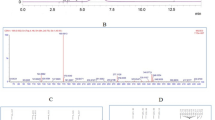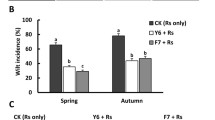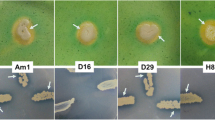Abstract
Plants constitutively produce a variety of secondary metabolites that have antimicrobial activities against phytopathogens; however, interactions between these performed antimicrobial compounds and phytopathogens were poorly understood. In this study, interactions between epigallocatechin gallate (EGCg), which was a major tea catechin that had antimicrobial activities against varieties of bacteria, and Pseudomonas syringae pv. theae (P.s. theae), the causal of bacterial shoot blight of tea, were investigated. EGCg had less antimicrobial activity against P.s. theae; however, subinhibitory concentrations of EGCg induced biofilm formation. Because biofilms are induced in the presence of sucrose in the culture medium but not by P.s. theae strains deficient in exopolysaccharide levan production, biofilm induction by EGCg and levan production are closely related. EGCg increased survival of P.s. theae under dry conditions on nonwounded leaf surfaces in the presence of sucrose. These data indicate the possibility that tea catechins affect the survival of P.s. theae on the phyllosphere.




Similar content being viewed by others
References
Arai K, Sakoda T, Nishi Y, Iwai H (2002) A new medium for isolation of Pseudomonas syringae pv. theae, the pathogen of bacterial shoot blight of tea plants. Jpn J Phytopathol 68:141–147
Ando Y (1988) Severe occurrence of bacterial shoot blight of tea plant associated with cold and frost damage. Bull Natl Res Inst Veg Ornam Plants Tea Jpn Ser B 2:41–45
D’Argenio DA, Miller SI (2004) Cyclic di-GMP as a bacterial second messenger. Microbiology 150:2497–2502
D’Argenio DA, Calfee MW, Rainey PB, Pesci EC (2002) Autolysis and autoaggregation in Pseudomonas aeruginosa colony morphology mutants. J Bacteriol 184:6481–6489
Hara Y (2002) Anti-bacterial and anti-virus activity of tea catechins. In: Muramatu et al. (eds) Health science of tea (Japanese), Gakkaishuppan center, Tokyo, pp 270–293
Hentzer M, Teitzel GM, Balzer GJ, Heydorn A, Molin S, Givskov M, Parsek MR (2001) Alginate overproduction affects Pseudomonas aeruginosa biofilm structure and function. J Bacteriol 183:5395–5401
Hodge JE, Hofreiter BT (1962) Determination of reducing sugars and carbohydrates. In: Whistler RL, Wolfrom JL (eds). Methods in carbohydrate chemistry. Vol 1. Academic, New York, pp 300–394
Hoffman LR, D’Argenio DA, MacCross MJ, Zhang Z, Jones RA, Miller SI (2005) Aminoglycoside antibiotics induce bacterial biofilm formation. Nature 436:1171–1175
Horie H, Kobata K (2002) Major components in tea leaves. In: Muramatu et al. (eds) Health science of tea (Japanese), Gakkaishuppan center, Tokyo, pp 26–31
Kulasakara H, Lee V, Brencic A, Liberati N, Urbach J, Miyata S, Lee DG, Neely AN, Hyodo M, Hayakawa Y, Ausubel FM, Lory S (2006) Analysis of Pseudomonas aeruginosa diguanylate cyclases and phosphodiesterases reveals a role for bis-(3′–5′)-cyclic-GMP in virulence. Proc Natl Acad Sci USA 103:2839–2844
Kodama K, Sagesaka Y, Goto M (1991) Antimicrobial activity of catechins against plant pathogenic bacteria and fungi. Ann Phytopathol Soc Jpn 57:306–311
Lindow SE, Brandl MT (2003) Microbiology of the phyllosphere. Appl Environ Microbiol 69:1875–1883
Monier JM, Lindow SE (2003) Differential survival of solitary and aggregated bacterial cells promotes aggregate formation on leaf surfaces. Proc Natl Acad Sci USA 100:15977–15982
Nishi Y, Sawada H, Matsuda I, Iwai H, Arai K (1997) Detection of Pseudomonas syringae pv. theae by polymerase chain reaction. Ann Phytopathol Soc Jpn 63:481
Okada F (1971) Inhibitory effects of tea catechins on the multiplication of plant virus I. Ann Phytopathol Soc Jpn 37:29–33
Osbourn AE (1996) Performed antimicrobial compounds and plant defense against fungal attack. Plant Cell 8:1821–1831
O’Toole GA, Kolter R (1998) Flagellar and twitching motility are necessary for Pseudomonas aeruginosa biofilm development. Mol Microbiol 30:295–304
O’Toole GA, Kaplan HB, Kolter R (2000) Biofilm formation as microbial development. Ann Rev Microbiol 54:49–79
Shimizu R, Taguchi F, Marutani M, Mukaihara T, Inagaki Y, Toyoda K, Shiraishi T, Ichinose Y (2003) The ΔfliD mutant of Pseudomonas syringae pv. tabaci, which secretes flagellin monomers, induces a strong hypersensitive reaction (HR) in non-host tomato cells. Mol Genet Genomics 269:21–30
Spiers AJ, Bohannon J, Gehrig SM, Rainey PB (2003) Biofilm formation at the air–liquid interface by the Pseudomonas fluorescens SBW25 wrinkly spreader requires an acetylated form of cellulose. Mol Microbiol 50:15–27
Tamayo R, Tischler AD, Camilli A (2005) The EAL domain protein VieA is a cyclic diguanylate phosphodiesterase. J Biol Chem 280:33324–33330
Tomihama T, Nishi Y, Arai K (2006a) The effects of exopolysaccharide production and flagellum on motility, biofilm formation, survival and virulence of Pseudomonas syringae pv. theae. Jpn J Phytopathol 72:3–13
Tomihama T, Nishi Y, Arai K (2006b) The effect of ice nucleation-active Xanthomonas campestris on the occurrence of bacterial shoot blight disease of tea caused by Pseudomonas syringae pv. theae. Jpn J Phytopathol 72:14–21
Weiner R, Seagren E, Arnosti C, Quintero E (1999) Bacterial survival in biofilms: probes for exopolysaccharide and its hydrolysis, and measurements of intra- and interphase mass fluxes. Methods Enzymol 310:403–426
Zogaj X, Nimtz M, Rohde M, Bokranz W, Römling U (2001) The multicellular morphotypes of Salmonella typhimurium and Escherichia coli produce cellulose as the second component of the extracellular matrix. Mol Microbiol 39:1452–1463
Acknowledgments
We thank to Dr. Nonaka F, Nonaka T, Nakamaura T, Uchimura K for helpful discussions.
Author information
Authors and Affiliations
Corresponding author
Electronic supplementary material
Below is the link to the electronic supplementary material.
Rights and permissions
About this article
Cite this article
Tomihama, T., Nishi, Y. & Arai, K. Epigallocatechin gallate, a major tea catechin, induces biofilm formation of Pseudomonas syringae pv. theae . J Gen Plant Pathol 73, 185–192 (2007). https://doi.org/10.1007/s10327-007-0005-0
Received:
Accepted:
Published:
Issue Date:
DOI: https://doi.org/10.1007/s10327-007-0005-0




